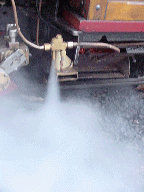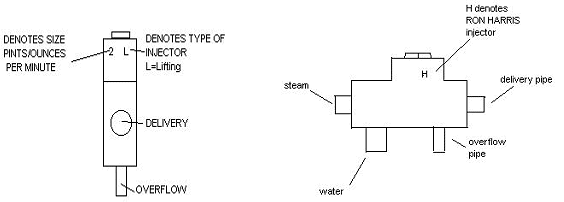
INJECTORS
Why an Injector?
Well, they're a simple little device that uses no extra power source. That through design and the use of live steam, can inject water into the boiler that supplies the steam. They were used to replace mechanical driven pumps, as injectors are very reliable and very efficient.
When Were They First Invented?
The oldest form of injector is known as the "Gifford" injector and was patented in July 1858. Much difficulty was experienced in applying the injector to locomotives due to hard starting and the interruptions due to track jolting caused by rough track. Fortunately they have been improved since then, and since the very early 1900's have been the primary water source for putting water into locomotive boilers.
What Are Injectors?
They are a device which is used by crew to take water from the tender and combine it with live boiler steam and inject it into the boiler via a check valve. It is achieved by opening the steam and water valves in their correct order, they will pick up and inject the water into the boiler.
But How Does The Injector Work?
This seems to be the hard bit, but it's really quite simple as well. Let me first explain a little about the parts of a basic injector. Compare it with an injector that you may have seen on a locomotive you may have driven. Firstly the body is known as the injector. It has several pipe connections, Live steam supply, water supply, overflow and delivery to the boiler. Inside, it has several conical shaped cones being, Steam, combining and delivery. This can be seen in the diagram below:
This explanation is based on an injector operating at 180 psi, but the principle remains the same with a small variation of speeds.
When the steam valve is opened, steam flows through to the steam cone. It is here where the cone reduces in size and this in turn, throttles the steam until it reaches a speed of approximately 1700 feet per second, 1,160 miles per hour or 1856 kph. At this speed it is admitted to the water space or combining cone. Where the steam is condensed and carries forward by the force of it's momentum about twelve times it's own weight of water at a speed of about 131 feet per second or nearly 90 miles an hour (144kph). The speed attained is sufficient to carry the combined jet across the space to the delivery tube, and through the check valve into the boiler.
Note, that when the steam mixes with the water and condenses, this is when it forms the vacuum. This then allows atmospheric pressure to push the water from the tender up into the injector (a very important action).
Lifting
This type being the most common type used at the railway. They are capable of lifting water from a lower source into the injector then forcing it past the check valve into the boiler. They can be placed above the water supply on the locomotive. (We normally place them at the bottom of the cab)
Non-Lifting
Very similar to lifting type, the main difference is that they can not lift water into the injector. That means that the water supply must be above the injector so that water flows through the injector freely.
That's the main difference, however, the operating of the injectors varies in the turning on procedure. The lifting injector works better with the steam turned on first, this allows for a vacuum to be formed causing the water to fill the void, under the influence of atmosphere pressure. Then turn on the water valve. The non-lifting injector must have the water on first. Then seeing the water flowing from the overflow, turn on the steam valve and it will work.
Turning off the injectors is the same for both. Turn off the steam first, then the water.
Trimming The Injector
When the boiler pressure is low and there is water wasting from the overflow. Slowly turn off the water supply to reduce the amount of water supplied to the injector until it stops wasting. This is called trimming the injector. The amount of water an injector can inject depends on steam pressure, water temperature and the distance that the feed has to be lifted.
The Use of The Injector
There are many theories regarding the use of the injector. There are some basic rules governing when you should use them and how.
The injector should ideally be used only with the locomotive steaming, however, it's neither always practicable nor desirable. Ideally, whilst steaming, the injector should be used to maintain the water level. The water level should be maintained at approximately ½ a glass on flat track or it's equivalent on grades. That would be approximately ¾ glass on steep rising grades and ¼ glass on steep falling grades.
When standing, do not add a large amount of water in one go but add a little then stop, wait for a little while, then add more, repeat this until you have built up a sufficient level. This is because water being injected into the boiler comes from the tender, which should be ambient temperature, much lower than boiler temperature. In the injector, water mixes with the hot steam, which is condensed. The steam and water mixture at a ratio of approximately 1 part steam to 12 parts water. The final water temperature therefore is much lower than that of the boiler water temperature. So, a large injection of the relatively cooler water will lower the water temperature in the boiler and therefore a reduction of boiler pressure will occur. This will put great stresses on the boiler and should be avoided. The adding of a continuous amount of water, whilst steaming, is good, as the fire is bright, heating up the water as it is being used. The boiler water is also circulating around the boiler by the motion of the boiler and thermal movements.
It's not good practice to have an injector so large that the water level builds up quickly whilst steaming, that it requires that it be turned off and on over short periods. It's better to have a smaller injector that can be left on for nearly the whole trip. It's also good practice to use both the injectors at different times to keep them in good working order.
Injectors are designed to work above the boiler pressure and down to approximately ½ of the boiler pressure dry. This is known as the dry range of the injector. This is where an injector will work from full pressure to approximately ½ of that pressure with no water wasting from the overflow. The injector will work down to lower pressures, down to approximately 20 PSI, but the water will need to be trimmed as the pressure drops, but as the pressure rises again, the water must be opened again, otherwise the injector will "knock off" from working.
The Ron Harris injectors are made to work with 100-PSI boilers and a "H" stamped into the side of the injector can identify them. The end has also been stamped with the type of injector and its feed rate. L = lifting type, 2 = 2 pints per minute and 4 = 4 pints per minute.
Common Faults, Causes and Remedies
1. Lack of Water Supply To Injector
Check water level in tender; add water to tender if low. Lid of tender forming a seal, open lid to break airtight seal. This is important because water flows to the injector by gravity on most miniature locomotives and if the lid seal tightly then a vacuum will form in the tender and the water will not flow.
2. Feed Pipe From Tank to Injector Chocked or Blocked
Clean the pipe, remove and clean filters and blow line clear. Blow back into the tender by opening the water valve fully, block the overflow then turn on the steam valve until you hear a gurgling sound from the tank, now the line is cleared. Note: be careful not to burn yourself.
3. Feed Water Pipe Leaking
Feed water supply is ok, but the injector doesn't pick up properly or water is wasting from the overflow. Test pipe work by turning off supply at the tender, block the overflow and turn on the steam a little. The leak will show itself. Repair or tighten leak.
4. Feed Water too Hot
If the injector does not pick up fully or at all and water is flowing from the overflow. It could be caused by the feed water, being too hot. Check its temperature. Injectors don't work well with hot water and if its too hot it will not work at all, so if the water is hot or too warm then it must be cooled. The injector will then pick up, if it doesn't then it may be something else.
5. Injector Over Heating
The injector will not work if it is too hot. This can be caused by a leaking steam valve or by the steam valve not being shut properly. Turn off the steam supply properly and run cold water through it to cool the injector body. You may need to cover it with a wet rag or pour cold water on it if it's a lifting Injector that's positioned so that water doesn't flow freely through the injector.
6. Scaled Up Cones
Under normal conditions, water will be seen wasting from the overflow or the injector will not work. A quick remedy is to blow steam through the injector to try and remove the scale and try again. If that fails then remove the injector and clean it using one tea spoon of citric acid in a cup of hot water for about 15 minutes then blow it clean with air and try again. A good practice is to blow steam through the injector at the end of the day for about 20 seconds to try to maintain it in a clean condition. Do not put water treatment in the tender, as this treatment will eventually scale up those cones. They are made to a very fine tolerance and so it does not take much to upset the balance.
7. Locomotive Priming
The boiler priming can be caused by too high water level for the work being performed or by the water foaming. In both cases lessen the workload the boiler is doing and also lower the water level to the correct level approximately ½ a glass. Priming is when water is being lifted and carried by the steam, and as a result the injector will not work until it again receives dry steam.
8. Steam Blowing Back
If steam is seen blowing back through the overflow whilst the injector is turned off, it will most likely be caused by the boiler clack valve blowing back. Tap the clack valve in an attempt to seat the valve. If this occurs frequently then look at cleaning the clack valve and wash out the boiler.
This article was written for DVR by the late Ian Pettersen
Reference was sourced from:
- Locomotive management from cleaning to driving
- V/line steam training manual
- Ron Harris operating instructions for his injectors
- and my own experiences


